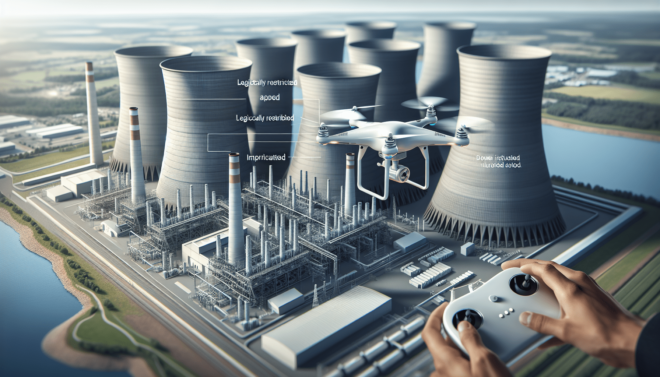Have you ever wondered why drones are prohibited from flying near Las Vegas’ power plants or utilities? You might be curious about the rationale behind such restrictions, especially if you are a drone enthusiast or someone interested in maintaining public safety.
Understanding Drone Regulations Near Critical Infrastructure
Flying a drone, while exhilarating and useful, comes with specific responsibilities and regulations. Let’s dig into why Las Vegas, a city known for its bustling energy and entertainment, has implemented no-fly zones around power plants and utilities.
Importance of Critical Infrastructure
Critical infrastructure refers to assets that are vital for the functioning of a society and economy. This includes power plants, water treatment facilities, and various utility services. In Las Vegas, such facilities are essential for maintaining the city’s liveliness and continuous operation.
Potential Risks of Unregulated Drone Flights
Drones, though small and seemingly harmless, can pose numerous risks if flown irresponsibly around critical infrastructure. These risks include:
| Risk Type | Potential Impact |
|---|---|
| Security Breaches | Unauthorized access to sensitive areas |
| Operational Disruption | Interference with the functioning of equipment and services |
| Safety Hazards | Risk of collisions that can cause physical damage |
| Data Privacy | Unauthorized surveillance and data collection |
Regulatory Framework
In the United States, the Federal Aviation Administration (FAA) sets regulations for drone operations. For areas like Las Vegas, additional local regulations are often integrated to address specific concerns around critical infrastructure.
Security Concerns
Security is a primary reason why drones are restricted near power plants and utilities in Las Vegas. Unauthorized drone flights can lead to severe security breaches with widespread consequences.
Threat of Terrorism
One significant concern is the threat of terrorism. Drones can be used for malicious purposes, including delivering explosives or conducting surveillance to acquire sensitive information for future attacks.
Espionage and Data Theft
Drones equipped with high-definition cameras and other sensors can capture detailed images and data. Important information about power grids, utility layouts, and security protocols can be gathered without permission, posing a substantial risk of espionage.
Operational Challenges
Flying a drone near critical infrastructure can disrupt operations in several ways, leading to potentially hazardous situations.
Electromagnetic Interference
Power plants and utilities rely on sophisticated electronic systems to function efficiently. Drones can interfere with these systems, causing malfunctions or operational failures.
Collision Risks
Drones can collide with critical infrastructure elements like cooling towers, transmission lines, or even workers. Such incidents not only disrupt services but also pose significant safety risks.
Emergency Response Complications
In emergency situations, ensuring clear airspace around critical infrastructure is crucial. Drones flying in restricted zones can complicate emergency response efforts, leading to delays and potentially exacerbating the situation.
Legal Implications
Operating a drone in restricted areas comes with legal consequences. Understanding these can help you appreciate the importance of adhering to regulations.
FAA Regulations
The FAA’s Part 107 rules govern the use of drones for commercial purposes. These rules include restrictions on flying over specific areas and mandate that operators provide prior notice when flying close to critical infrastructure.
Local Ordinances
Las Vegas may have additional local ordinances that impose stricter rules on flying drones around critical infrastructure. Violating these local regulations can result in fines, confiscation of the drone, and other penalties.
Case Studies of Violations
Reviewing case studies of violations can provide a clearer picture of why these rules are stringent. For instance, unauthorized drone flights near Hoover Dam have resulted in considerable fines and bring light to the severe security protocols in place for such critical infrastructure.
How to Fly Drones Responsibly
Now that you understand the importance of these restrictions, you might be wondering how to enjoy flying your drone responsibly within legal limitations.
Obtain Necessary Permissions
If you have a legitimate reason to fly near critical infrastructure, securing proper permissions is crucial. Contacting the FAA and local authorities can provide guidance on obtaining the necessary clearances.
Use Safe Zones
Las Vegas offers ample opportunities for drone enthusiasts to explore safe and designated flying zones. Researching and sticking to these areas ensures you are flying responsibly and within legal boundaries.
Operator Training
Investing in drone operator training can help you understand the regulatory landscape better. Certified training programs often include detailed information on no-fly zones and how to navigate the complexities of drone regulations.
Updated Knowledge
Drone regulations can evolve rapidly. Staying updated with the latest FAA guidelines, local ordinances, and technological advancements will help you remain compliant with the law and ensure safe flying practices.
Conclusion
The restrictions on flying drones near Las Vegas’ power plants and utilities are well-founded and serve to protect critical infrastructure, ensure operational safety, and mitigate legal ramifications. You, as a drone operator, play a pivotal role in maintaining public safety and adhering to these regulations is not just a legal requirement but a social responsibility.
By understanding the reasoning behind these no-fly zones, you can enjoy the fascinating world of drone flight while contributing to the safety and security of vital infrastructure. So, ensure you follow the rules, stay informed, and fly safely!

